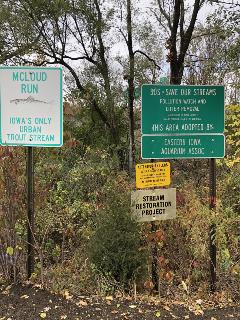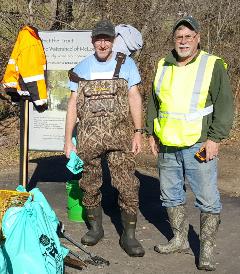Iowa >> Of all 88 trout streams in Iowa, McLoud Run in Cedar Rapids is the only one in an urban area. Like a lot of streams these days, it gets storm water runoff and is highly susceptible to flash flooding and seasonal temperature variations despite the cool spring water that feeds it.
That means this trout stream needs some love and attention.
In November 2020, I joined Linn County Chapter’s Conservation Chair Neil Mittelberg and new Linn County Ike Tom Sandersfeld in cleaning up a quarter-mile section of the McLoud Run stream. The stream is periodically stocked with brook, brown and rainbow trout by the Iowa Department of Natural Resources (DNR). The two-and-a-half miles of stream is catch-and-release only, and the adjacent trails encourage picnickers, hikers, bikers and wildlife watchers.
Tom had recently participated in the League’s Save Our Streams (SOS) Field Training session (led by national staff member Zachary Moss). Tom’s interest in the SOS training sparked him to join the Linn County Chapter. Neil contacted Tom when we learned of his interest in conservation activities, via Zachary, and since Tom was going to do a solo cleanup the next week, we asked if he’d like help, which he gladly accepted.
 SOS signage posted at the J Avenue entrance to McLoud Run.
SOS signage posted at the J Avenue entrance to McLoud Run.
There is a lot of history associated with McLoud Run. In its early rural days, it was strictly a spring-fed stream, complemented by natural rainfall and snowmelt runoff from an approximately four-square-mile area. As the city expanded, storm sewers were added, and with the construction of I-380 in the 1970s, the stream was straightened to run parallel to the interstate. Even with the addition of this major freeway, the spring continued to provide its cool waters.
In 1997, the Iowa DNR, along with area organizations, saw an opportunity to stock McLoud Run with trout and provide an urban fishing opportunity. To provide hiding spots for the trout, fish-bank hides were added (these are heavily constructed, low-profile boxes embedded in the embankment) along with stream riffles, created by placing rocks in the shallow areas.
Through the years, groups such as the Hawkeye Fly Fishing Association, the Eastern Iowa Aquarium Association, the Boy Scouts of America, local neighbors and businesses along with the League have promoted clean-ups, restoration events, filter gardens and holding ponds, all in an attempt to maintain a viable waterway.
Sadly, in August 2020, the McLoud Run trail and stream had a number of downed trees in it after an unprecedented windstorm. The city went to great lengths to clear the debris and make the trails passable. The stream itself was in fairly good shape, but the banks were quite littered with wreckage.
So, in November, our three-person team worked the banks and creek bottom for a couple of hours. Due to the COVID-19 guidelines, we did our best to maintain distances from each other as we worked. The water level was down, but so were many trees from the windstorm, so the going was slow. Neil worked the middle of the stream because he wore chest waders, while Tom and I worked either side. It was a very warm day for November and jackets were quickly shed as the walking was hard due to the downed trees and branches, some of which hung over the banks. Our bags of debris quickly became heavy. In addition to two pallets, wooden fence posts and large metal objects, we estimated we removed 200 pounds of material.
 Neil and Dale with some of their 200 pounds of collected trash.
Neil and Dale with some of their 200 pounds of collected trash.
The Linn County Chapter has long provided stewards of rivers and streams in Cedar Rapids. In 1994, the chapter began their Save Our Streams campaign and promoted the Cedar River Watch program. This effort was headed up by member Norm Fluegel who went to great efforts to get organizations to adopt portions of the Cedar River and its tributaries for the purpose of cleaning them up. Once a group adopted (committed to cleanup and monitoring), the chapter posted signage at river ramps and tributaries indicating what group had adopted that portion of the waterway. Norm’s efforts garnered him the League’s Conservationist of the Year award at both the Iowa Division and national levels. The chapter carried on this effort for several years but sadly, with Norm’s passing in 2004, the program tapered off.
However, in 2018, the chapter, with a new set of leaders and interested members, began to revitalize their SOS water quality presence. Neil and I have worked with the national office to schedule SOS Stream Monitoring classes and events, using McLoud Run as a starting point. The chapter has also started a Salt Watch on the stream and will be participating in an expanded Cedar River Monitoring effort from Cedar Rapids to its headwaters near Austin, Minnesota.
Our future plans? The chapter will be working with its members and the community to underscore the importance of keeping McLoud Run a viable, clean waterway. We have plans to contact interested individuals, other groups and the City of Cedar Rapids as well as the Iowa DNR to promote clean water efforts. We will also continue to offer SOS training to the community and Winter Salt Watch kits to those who are interested.
We do this not only for the trout that reside in McLoud Run but also for the land along its banks and other waterways in our county.